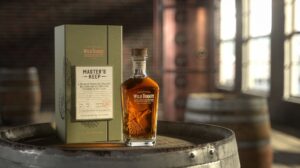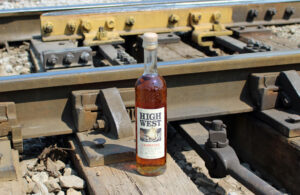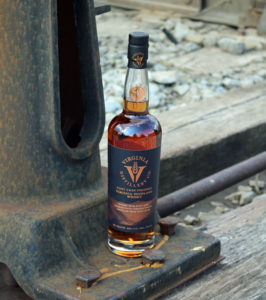Updated December 8, 2022
By Richard Thomas
 Wild Turkey’s most important contribution to the realm of annual limited edition whiskeys has been Master’s Keep, which has put several noteworthy spins on Wild Turkey’s bourbon, plus one rye installment in the form of Master’s Keep Cornerstone. This year, Master Distiller Eddie Russell decided to look back to something he created back when he was still first lieutenant to his Dad, the living legend Jimmy Russell, by resurrecting Forgiven.
Wild Turkey’s most important contribution to the realm of annual limited edition whiskeys has been Master’s Keep, which has put several noteworthy spins on Wild Turkey’s bourbon, plus one rye installment in the form of Master’s Keep Cornerstone. This year, Master Distiller Eddie Russell decided to look back to something he created back when he was still first lieutenant to his Dad, the living legend Jimmy Russell, by resurrecting Forgiven.
As the story goes, in 2010 some bourbon that was meant for a small batch product found its way into the same batching tank as a consignment of high proof rye was already in. Usually when one hears a story like this in the whiskey business, the result is flushed, and so brings tears to the eyes of many an enthusiast. In this case, it was a happy accident, and was released (after some father-to-son grumbling) as Wild Turkey Forgiven. Or so the story goes.
Forgiven was the first high profile example of a class of whiskeys called hybrids, so named because they blend two distinct classes of whiskeys together. Since the run of Wild Turkey Forgiven (2010 to 2014), a handful of hybrids have gone on to become fan favorites or annual limited editions. For Russell to put a golden crown on the hybrid category with a Master’s Keep release is really quite appropriate.
Master’s Keep Unforgotten draws on 13 year old bourbon and 8 and 9 year old ryes, which are married and then finished as a blend in Wild Turkey’s own rye barrels. It’s bottled at 105 proof, with an MSRP of $200.
23rd Street Distillery Hybrid Whisk(e)y: Here is an odd duck in a flock of odd ducks. 23rd Street Distillery is an Australian outfit, but here they are with a hybrid of imported American bourbon and Scotch whisky. As if that weren’t peculiar enough, they decided to name it after the term designed to avoid offending certain obtuse snobs who insist all references to the drink be spelled sans “e,” regardless of local versions of English, tradition or the style guide in use. Cheeky!
The Glover Whiskies: The company called The Fusion was founded to underline the cultural and economic ties between Japan and Scotland, and what better way to do that than to bring together their whiskies. The Glover has seen four releases since 2016: two 18 year olds, a 22 year old and a 14 year old. All are hybrid vatted malts (no grain whiskies), and all were done in batches of 1,500 bottles or slightly less. Of the four, the only one you are likely to see outside of the shelves of hardcore collectors or at the most rarefied whiskey bars is the 14 year old.
High West Campfire: This fan favorite from Utah recently saw a reboot. The current version of High West Campfire, long a favorite with enthusiasts, incorporates High West’s in-house rye whiskey; stock rye and bourbon acquired from MGP; and imported Scotch malt whisky from an undisclosed distillery.
Keeper’s Heart: Brian Nation, former Master Distiller of Jameson’s New Midleton Distillery, has brought together his old job with his current work in this expression. Collaborating with David Perkins of the aforementioned High West, this hybrid brings together Irish pot still and grain whiskeys with (depending on the specific release in question) American bourbon or rye.
The Little Books: The previous title holders for most premium of hybrids were found in Jim Beam’s Little Book series, the whiskeys created by their heir apparent, Freddie Noe. The first Little Book, from back in 2017, was a blend of bourbon, rye, malt and corn whiskey. Chapter Two drew on Kentucky rye plus two different stocks of Canadian whisky; Chapter Five was malted rye and bourbon; and the most recent Chapter Six uses American malts and bourbon. Chapters Three and Four drew on various types of bourbon, but since all of it was bourbon, neither qualifies as a hybrid.
Rebel Yell American Whiskey: Predating Forgiven and occupying the bargain basement rung of the hybrid class is Rebel Yell’s American Whiskey, a blend of their stocks of bourbon and rye.
Back before brand-owner Luxco had any distilleries to call their own, the stocks of whiskey going into these bottles were sourced from MGP. But first the company built Lux Row Distillery and then acquired ownership of Limestone Branch Distillery, before in turn being bought by MGP itself last year. Rebel Yell products, including American Whiskey, could stay at MGP or come from a variety of sources in the middle term future.
Suntory Ao: This one is so much of a hybrid that it was labeled a “world whisky.” Keeping in mind that Beam Suntory owns whiskey distilleries in all of the traditional five whiskey-making areas of the globe, the breadth of that label is entirely appropriate. Suntory Master Blender Shinji Fukuyo brought together The Yamazaki and The Hakushu; Ardmore and Glen Garioch; Jim Beam; Cooley; and Alberta Distillers. It’s around the world in a bottle, instead of a hot air balloon in 80 days.
Virginia Distilling Company Virginia-Highland Whiskey: Back when they were getting started, Virginia Distilling Company’s expressions were hybrids of their in-house malt whiskey and imported Scottish malts, then given a finish in casks sourced from some other Virginia-based booze-maker. We’ve reviewed the Cider Cask and Port Cask whiskeys, but there are two other versions as well.
The distiller has since introduced Courage & Conviction, their entirely in-house series of malt whiskeys, but the Virginia-Highland series is well-made and well-finished. It continues to merit attention, and I encourage anyone with an interest in either hybrids or American malts to acquire a bottle. One never knows when the company might decide to discontinue the series.
Wyoming Whiskey Outryder: This hybrid draws on an “almost rye” whiskey and a high rye bourbon, so it’s often thought of as being rye-forward without actually going there. This expression has evolved somewhat over the years, because when it originally came out the bourbon component was specified as the standard Wyoming Whiskey stock: 68% corn, 20% winter rye, and 12% malted barley. The “almost rye” stuff of 48% winter rye, 40% corn, and 12% malted barley falls into a category of whiskeys with a mash bill that doesn’t really qualify as any major American category, in the same vein as Michter’s Sour Mash.
Honorable Mentions
Basil Hayden had a pair of hybrids in the past, with their Two By Two and Caribbean Reserve Rye. They also have periodically released batches of Dark Rye, but we chose not to cover that above because it contains California Port wine in addition to its American and Canadian rye whiskies.
Jim Beam Kentucky Dram: This hybrid of Beam-owned Scottish malt whisky and their own bourbon was launched several years ago as a travel retail product. It has since been discontinued.
Teeling Hybrid: Despite originating from Ireland’s Teeling Whiskey Company, Teeling Hybrid is mostly Scottish. The recipe of this vatted malt hybrid is approximately 85% Bruichladdich malt, with the rest from Cooley.
 The Whiskey Reviewer A World of Whiskey, Poured Every Weekday
The Whiskey Reviewer A World of Whiskey, Poured Every Weekday


